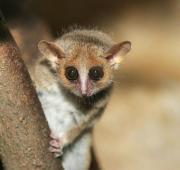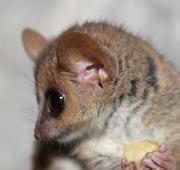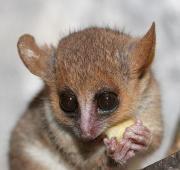 The gray mouse lemur is one of the world's smallest primates, and one of the smallest lemurs on the island of Madagascar. The gray mouse lemur was named after it's size and appearance that resembles that of a mouse (in a similar way to the other mouse lemur species). Although threatened, the gray mouse lemur is considered to be one of the most abundant primates on the island.
The gray mouse lemur is one of the world's smallest primates, and one of the smallest lemurs on the island of Madagascar. The gray mouse lemur was named after it's size and appearance that resembles that of a mouse (in a similar way to the other mouse lemur species). Although threatened, the gray mouse lemur is considered to be one of the most abundant primates on the island. Like all other lemur species, the gray mouse lemur is native to, and found only on, the island of Madagascar, off the eastern coast of Africa. Grey mouse lemurs inhabit native tropical woodlands and forests where they spend the majority of their lives nesting in the trees. Grey mouse lemurs are usually found perching on thin branches and occupy ranges of up to 5 acres in size.
Like all other lemur species, the gray mouse lemur is native to, and found only on, the island of Madagascar, off the eastern coast of Africa. Grey mouse lemurs inhabit native tropical woodlands and forests where they spend the majority of their lives nesting in the trees. Grey mouse lemurs are usually found perching on thin branches and occupy ranges of up to 5 acres in size.

In the same way to the island's other species of lemur, the gray mouse lemur is a generally nocturnal animal, spending it's days resting in the safety of the trees. Grey mouse lemurs emerge after dark when they are able to forage in the surrounding forest for food, and are not quite so easy for hungry predators to detect. The large eyes of the gray mouse lemur mean that it can see more easily under the cover of night.
The gray mouse lemur is an omnivorous animal, eating almost anything that it can find. Grey mouse lemurs primarily hunt and feed on insects both in the trees and on the ground. Fruits, nuts, berries, shoots and the occasional passing rodent, make up the rest of the gray mouse lemur's diet. Grey mouse lemurs usually hunt alone but spend their days resting in the trees with a number of other gray mouse lemurs.
Due to their small size, gray mouse lemurs can often be hard to spot in the dense forest but they are still successfully hunted by a number of Madagascan predators including birds of prey such as eagles and owls, various snakes and of course, the fossa, which is an animal that has evolved to hunt and eat lemurs in the forest.
The night-dwelling nature of this tiny primate means that there is limited information on more complex behaviours of the gray mouse lemur including how it reproduces. Grey mouse lemurs breed during September and October, when after a gestation period of roughly 2 months, 2 or 3 young are born. The baby gray mouse lemurs are cared for by their mother until they are big enough to become independent.
Today, although one of the most common primates on Madagascar, the gray mouse lemur is considered to be a threatened species mainly due to habitat loss caused by drastic deforestation across the island. A number of Madagascar's native trees however, have recently been listed by the IUCN hopefully meaning a decrease in the deforestation of natural woodlands there.

